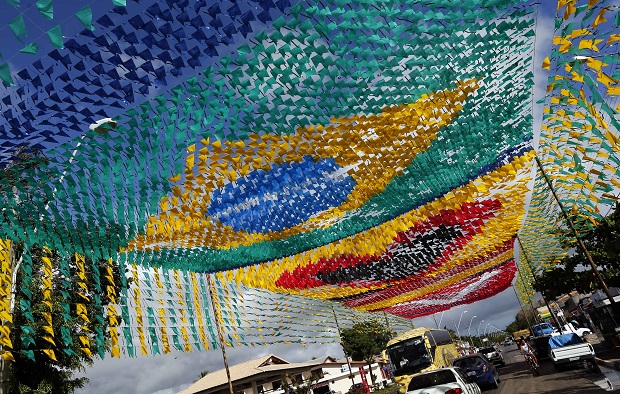
A street is decorated with national flags of countries participating in the 2014 FIFA World Cup near Santa Cruz Cabralia, Brazil, Wednesday, June 11, 2014. Soccer fans around the world are gearing up to watch the World Cup soccer tournament that kicks off in Sao Paulo, Thursday. AP
PARIS — Beyond the spectacle of 32 nations battling for the greatest prize in football, the World Cup is also a test bed for tackling climate-damaging carbon emissions from major events.
The world’s biggest sports fest is a major source of carbon, but FIFA says this year’s event should break new ground in addressing the problem.
It describes the 2014 show as a “stepping stone” towards “sustainable” World Cups by evaluating and reducing the carbon footprint.
From 2018, World Cups go into a new, greener phase, because environmental protection will be a mandatory requirement in hosting the contest.
FIFA estimates the Brazil event will produce about 2.7 million tons of emissions as measured in carbon dioxide equivalent (CO2e) — roughly the total emissions of Iceland over a six-month period.
“It’s not just about the number of flights from A to B, it’s also the tons of cables that are being used in TV production and the number of hours the refrigerators will be running during the World Cup,” said Federico Addiechi, FIFA’s head of corporate social responsibility.
But outside observers such as Frederic Chome, director of Belgium-based carbon consultancy Factor X, say the real tally is even higher.
“The problem with these sporting events is that they fail to factor in many emissions sources,” he told AFP.
Missing from the FIFA inventory are preparations like stadium construction, which uses vast amounts of carbon-spewing cement, and manufacturing, transporting and use of World Cup-related products.
“Big international events like this cause TV sales to rise by one percentage point, which is about 20 million individual sets,” Chome pointed out.
“If you consider that one TV costs 5-6 tons of CO2 to make, that makes at least 100 million additional tons of CO2. And then you add a billion televisions drawing power for three hours a day over three weeks, that makes another two million tons of CO2.”
Many smaller, apparently invisible items add to the footprint.
FIFA is issuing sets of World Cup uniforms — two pairs of trousers, three T-shirts, a jacket, a jersey, a cap and a rain poncho — to 2,880 people who have been hired for the event.
The outfits were made in China and shipped nearly 20,000 kilometers (12,400 miles) to Rio.
They were then transported another 1,660 km to the host cities. The result: about 436 tons of CO2e.
It all adds up, say the experts, but the single biggest polluter is always transport.
It accounts for more than 80 percent of World Cup emissions, mainly through international carriers ferrying the estimated 40 percent of international fans to Brazil. Some of the host venues are more than 3,000 km apart.
Going greener
Brazil estimates that 60,000 tons of direct emissions will result from accommodation, domestic flights and ground transport, construction and tournament “operations.”
These will be more than offset by 115,000 tons of carbon credits donated by local companies and projects, it says.
The credits, essentially permits to emit greenhouse gases, can be sold if unused, and form part of international efforts to curb Earth-warming carbon pollution through fossil fuel consumption.
Once indirect emissions from international flights and tourism are added, Brazil has calculated the total emissions at 1.4 million tons, compared to FIFA estimated output of 2.7 million.
FIFA has said it will offset 251,000 ton through projects worth about $2.5 million (1.9 million euros) that could include reforestation, or building wind farms and hydroelectric plants.
The previous host, South Africa, emitted 1.65 million tons of World Cup greenhouse gases — a million tons less than predicted, partly because fewer tourists came.
Brazil’s emissions could therefore be much higher, although it uses less-polluting energy obtained in large part from hydro-generation.
“Big sporting events are increasingly winning green medals for their environmental performance,” says UN climate chief Christiana Figueres, although Chome cautions that a truly green sports event is “a flight of fancy”.
“The best we can do is to have much stricter environmental criteria from the point of determining candidate hosts,” he said.
RELATED STORIES
Fashion experts weigh in on World Cup jersey style
Brazil sky-high prices shock World Cup tourists

